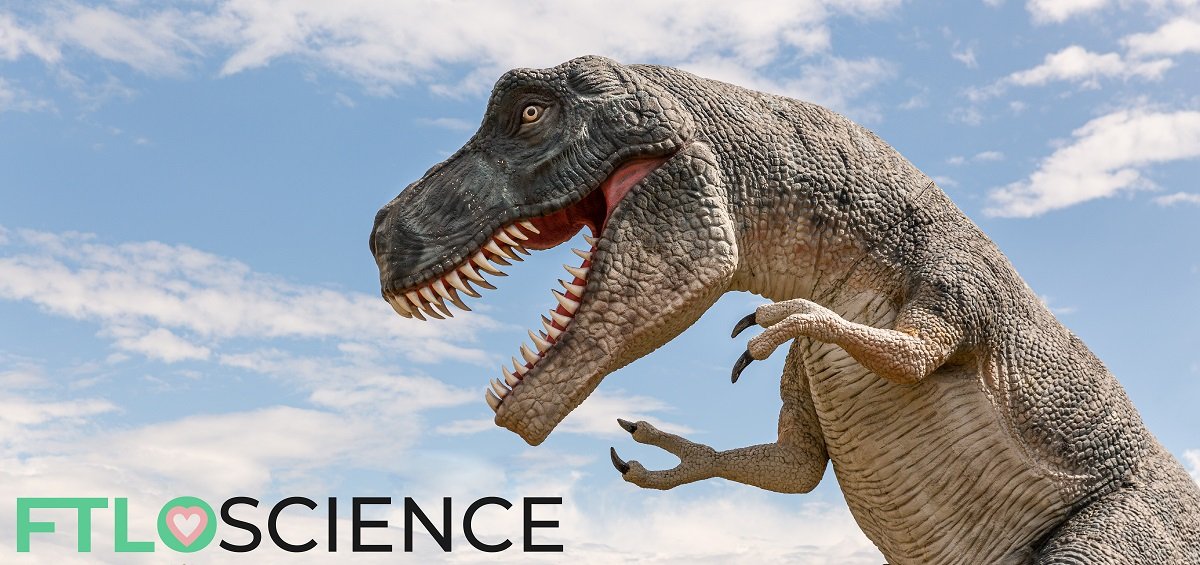No, not that kind of dating… Rather, ‘dating’ a dinosaur bone dug out of the ground involves a series of processes that allow us to estimate its age on this Earth. This helps us to understand how that species fits into the evolutionary tree of change. When did a species first appear and when did the last of their kind walk this Earth? Let’s look at radiometric dating and how this technology is used in dating fossils millions of years old!
We date dinosaur fossils by looking for nearby zircon, a common mineral in rocks. Using radiometric dating techniques, we can tell how much uranium and lead is present in zircon. The proportions of each allow us to accurately perform dating of dinosaur fossils from hundreds of millions of years ago.
Dating Dinosaur Fossils (and Other Very Old Stuff)
Radioactive Decay of Atoms
Not all elements in the periodic table are created stable. Some break down into smaller fragments in a process called radioactive decay.
Radiometric dating exploits the radioactive decay of these unstable atoms naturally present in the structure of bones and rocks. These atoms (radioactive isotopes) have a unique ‘half-life’, which is the amount of time it takes for half of the atoms in a given sample to decay.
Radioactive isotopes, such as iodine-131, can decay multiple times in what is known as a decay chain. Being radioactive, they release ionizing radiation every time they progress through each step in the decay chain. This continues until a non-radioactive, stable isotope forms at the end of the chain. In iodine decay, the stable isotope that forms is xenon, a noble gas.
Radiometric Dating
On the surface, radioisotopes and stable products are free to react and swap places, so they’re not very useful in telling the age of you and me. However, for fossils and dinosaur bones buried deep within the each, their atoms cannot escape.
This means we can dig up old dinosaur bones and other material that is buried under layers of sediment, and go searching for the amounts of unstable and stable isotopes to determine how long its been trapped under the Earth.
Comparing the ratio of unstable isotopes vs. its stable decay products in objects to determine its age is called radiometric dating.
Different Radioisotopes to Date
Carbon Dating
When dating a specimen, there are many different isotopes that can be tracked. You’ve probably heard of carbon dating, developed by Willard Libby, who went on to win the Nobel Prize in Chemistry for it in 1960.
The technique is based on radiocarbon (14C) which is created high up in the atmosphere and then incorporated into all carbon-based life forms. You probably have some radiocarbon inside of you right now, but not much, because the ratio of radiocarbon to normal carbon (12C) is about one in a trillion (1 in 1,000,000,000,000)!

Radiocarbon undergoes beta decay to form the stable isotope 14N, with a known half-life of about 5730 years1. A carbon clock setup can measure the amount of radiocarbon is in bones and artifacts to tell its age.
Now, carbon dating is pretty cool if you want to calculate the age of a tree, for example, or even an Ancient Egyptian king a few thousand years young. But with dinosaur bones being millions of years old, radiocarbon present would have long since decayed. You see, radiocarbon dating is only useful for about samples that are younger than 75 000 years old2.
Uranium-Lead Dating
Accurate dating of samples requires that the parent radioactive isotope has a long enough half-life such that it will still be quantifiable today. Luckily for us, Uranium-Lead (U-Pb) dating is suitable for dinosaur age samples, being able to accurately date rocks (yes, rocks, we’ll come to that later) between 1 million and 4.5 billion years old3.
Two decay chains are measured in this type of radiometric dating, 238U → 206Pb and 235U → 207Pb, where two isotopes of uranium form two isotopes of lead. They do this through alpha and beta radioactive decay, with half-lives of around 4.5 billion years and 700 million years, respectively4.
Ingenious Fossil Dating using Igneous Rock
Zircons: More Valuable than Diamonds
Uranium-Lead dating is useful for telling us the age of very old things because of its long half life. However, there is usually too little uranium present in dinosaur bones to date them directly through this method.
While paleontologists look for bones, scientists who are interested in radiometric dating are always on the lookout for nearby igneous rock (rock formed from magma). This is usually in the form of a mineral called zircon (ZrSiO4). Zircon is special because:
- Zircon contains a relatively high amount of uranium (100–1000 parts per million)
- Lead present in the surroundings does not enter and contaminate the mineral. Therefore, lead found in zircon samples comes solely from uranium decay.
- Zircon has an unusually high resistance to chemicals and weathering, so it is more likely to be preserved than bones and other rocks.
Scientists bring zircon back to the lab and perform uranium-lead dating to find out its age. They then assign this age to all the material found in the same sedimentary layer as the zircon. Dinosaur fossils are dated this way with a good degree of accuracy.

Telling Radioisotopes Apart by Mass
Now, some of you might be asking: “It’s all well and good knowing that radioisotopes decay to form different elements, but how do we actually count how much there is in rocks and fossils?”
Isotopes of an element differ just by their number of neutrons in their nucleus, for example, 12C simply has 2 neutrons less than 14C. In terms of charge, they are identical, meaning that they have the same chemical properties. However, mass spectrometry (MS) can be employed to exploit their tiny differences in mass.
Many variations of mass spectrometry exist, but they work by a similar principle. The sample is first vaporized (turned into gas) and ionized (turned into positively charged ions), then accelerated along the length of a tube.
An electric and magnetic field deflects the stream of high-speed ions, separating them based on their mass/charge ratio. Mass analyzers placed at the end of the tube can detect these, hopefully with enough sensitivity to tell the isotopes apart.

Reference
- Stuiver, M., & Polach, H. A. (1977). Discussion reporting of 14 C data. Radiocarbon, 19(3), 355-363.
- Walker, M., & Walker, M. J. C. (2005). Quaternary dating methods. John Wiley and Sons.
- Ewing, R. C., Meldrum, A., Wang, L., Weber, W. J., & Corrales, L. R. (2003). Radiation effects in zircon. Reviews in Mineralogy and Geochemistry, 53(1), 387-425.
- Jaffey, A. H., Flynn, K. F., Glendenin, L. E., Bentley, W. T., & Essling, A. M. (1971). Precision measurement of half-lives and specific activities of U 235 and U 238. Physical Review C, 4(5), 1889.
About the Author

Sean is a consultant for clients in the pharmaceutical industry and is an associate lecturer at La Trobe University, where unfortunate undergrads are subject to his ramblings on chemistry and pharmacology.




